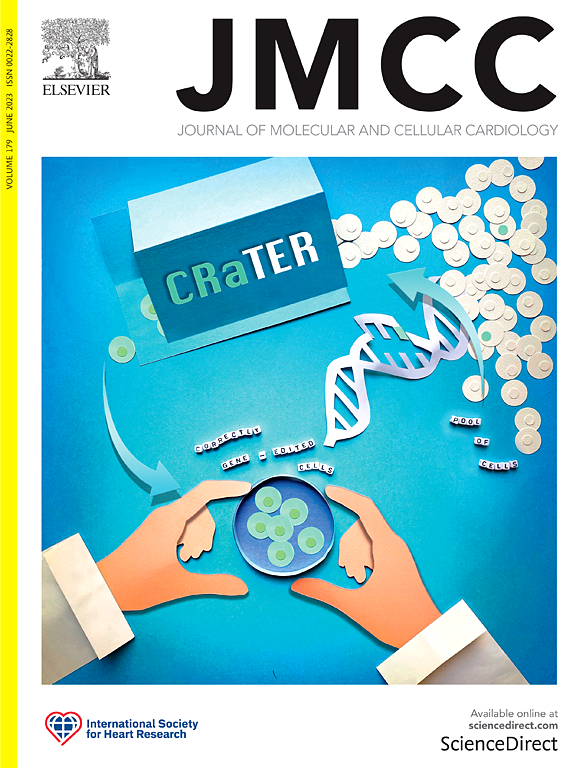Elevated KCa3.1 expression by angiotensin II via the ERK/NF-κB pathway contributes to atrial fibrosis
IF 4.7
2区 医学
Q1 CARDIAC & CARDIOVASCULAR SYSTEMS
引用次数: 0
Abstract
Atrial fibrillation (AF) is a prevalent cardiac arrhythmia characterized by atrial fibrosis which involves excessed proliferation and increased activity of fibroblast and myofibroblast, as well as alterations in the extracellular matrix (ECM). The specific mechanism driving fibrosis in atrial fibroblasts and myofibroblsats remains incompletely understood. This study investigates the role of the intermediate-conductance Ca2+-activated K+ channel (KCa3.1) in Angiotensin II (Ang II)-induced atrial fibrosis and elucidates the underlying mechanisms. Primary rat atrial fibroblasts/myofibroblasts were treated with Ang II to evaluate KCa3.1 expression, cells proliferation and ECM production. The involvement of ERK/NF-κB signaling pathway was assessed using specific inhibitors. Ang II treatment increased KCa3.1 expression, stimulated the proliferation of fibroblasts/myofibroblasts, and enhanced ECM production, effects that were attenuated by the Ang II receptor antagonist Losartan and the KCa3.1 inhibitor TRAM-34. Knockdown of KCa3.1 using siRNA significantly reduced Ang II-induced collagen synthesis, confirming its critical role in fibrosis. The ERK/NF-κB pathway was found to mediate Ang II-induced upregulation of KCa3.1, as evidenced by inhibition with specific inhibitors. In vivo, Ang II infusion in rats increased KCa3.1 expression and atrial fibrosis, with atria showing greater susceptibility to fibrosis compared to ventricle. These effects were mitigated by losartan and TRAM-34. In conclusion, our findings demonstrate that Ang II-induced upregulation of KCa3.1 through ERK/NF-κB pathway activation in atrial fibroblasts/myofibroblasts promotes cellular proliferation and collagen deposition, ultimately contributing to atrial fibrosis. KCa3.1 represents a promising therapeutic target for the treatment of atrial fibrosis in AF.

血管紧张素II通过ERK/NF-κB途径升高KCa3.1表达有助于心房纤维化。
心房颤动(AF)是一种常见的心律失常,其特征是心房纤维化,包括成纤维细胞和肌成纤维细胞的过度增殖和活性增加,以及细胞外基质(ECM)的改变。驱动心房成纤维细胞和肌成纤维细胞纤维化的具体机制尚不完全清楚。本研究探讨了中导Ca2+激活的K+通道(KCa3.1)在血管紧张素II (Ang II)诱导的心房纤维化中的作用,并阐明了其潜在机制。用Ang II处理原代大鼠心房成纤维细胞/肌成纤维细胞,观察KCa3.1的表达、细胞增殖和ECM的产生。使用特异性抑制剂评估ERK/NF-κB信号通路的参与情况。Ang II处理增加了KCa3.1的表达,刺激了成纤维细胞/肌成纤维细胞的增殖,并增强了ECM的产生,这些作用被Ang II受体拮抗剂氯沙坦和KCa3.1抑制剂TRAM-34减弱。使用siRNA敲低KCa3.1显著减少Ang ii诱导的胶原合成,证实其在纤维化中的关键作用。我们发现ERK/NF-κB通路介导Ang ii诱导的KCa3.1上调,特异性抑制剂的抑制证明了这一点。在体内,大鼠输注Ang II增加KCa3.1表达和心房纤维化,心房比心室更容易发生纤维化。氯沙坦和TRAM-34减轻了这些影响。总之,我们的研究结果表明,Ang ii通过激活心房成纤维细胞/肌成纤维细胞的ERK/NF-κB通路,诱导KCa3.1上调,促进细胞增殖和胶原沉积,最终导致心房纤维化。KCa3.1是治疗房颤心房纤维化的一个有希望的治疗靶点。
本文章由计算机程序翻译,如有差异,请以英文原文为准。
求助全文
约1分钟内获得全文
求助全文
来源期刊
CiteScore
10.70
自引率
0.00%
发文量
171
审稿时长
42 days
期刊介绍:
The Journal of Molecular and Cellular Cardiology publishes work advancing knowledge of the mechanisms responsible for both normal and diseased cardiovascular function. To this end papers are published in all relevant areas. These include (but are not limited to): structural biology; genetics; proteomics; morphology; stem cells; molecular biology; metabolism; biophysics; bioengineering; computational modeling and systems analysis; electrophysiology; pharmacology and physiology. Papers are encouraged with both basic and translational approaches. The journal is directed not only to basic scientists but also to clinical cardiologists who wish to follow the rapidly advancing frontiers of basic knowledge of the heart and circulation.

 求助内容:
求助内容: 应助结果提醒方式:
应助结果提醒方式:


